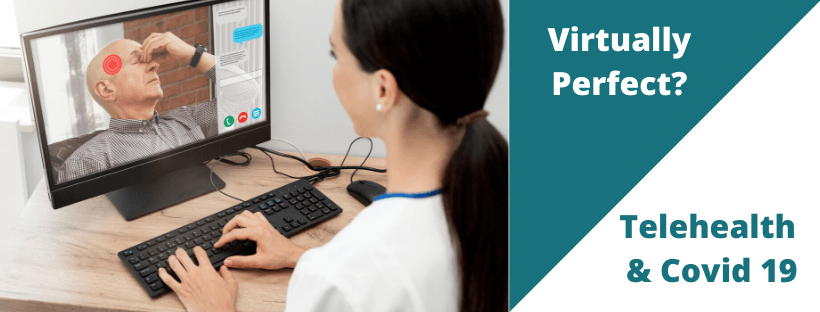Authors: Judd E. Hollander, M.D., and Brendan G. Carr, M.D.
Article Source:https://www.nejm.org/doi/full/10.1056/NEJMp2003539
Recognizing that patients prioritize convenient and inexpensive care, Duffy and Lee recently asked whether in-person visits should become the second, third, or even last option for meeting patient needs. Previous work has specifically described the potential for using telemedicine in disasters and public health emergencies. No telemedicine program can be created overnight, but U.S. health systems that have already implemented telemedical innovations can leverage them for the response to Covid-19.
A central strategy for health care surge control is “forward triage” — the sorting of patients before they arrive in the emergency department (ED). Direct-to-consumer (or on-demand) telemedicine, a 21st-century approach to forward triage that allows patients to be efficiently screened, is both patient-centered and conducive to self-quarantine, and it protects patients, clinicians, and the community from exposure. It can allow physicians and patients to communicate 24/7, using smartphones or webcam-enabled computers. Respiratory symptoms — which may be early signs of Covid-19 — are among the conditions most commonly evaluated with this approach. Health care providers can easily obtain detailed travel and exposure histories. Automated screening algorithms can be built into the intake process, and local epidemiologic information can be used to standardize screening and practice patterns across providers.
More than 50 U.S. health systems already have such programs. Jefferson Health, Mount Sinai, Kaiser Permanente, Cleveland Clinic, and Providence, for example, all leverage telehealth technology to allow clinicians to see patients who are at home. Systems lacking such programs can outsource similar services to physicians and support staff provided by Teladoc Health or American Well. At present, the major barrier to large-scale telemedical screening for SARS-CoV-2, the novel coronavirus causing Covid-19, is coordination of testing. As the availability of testing sites expands, local systems that can test appropriate patients while minimizing exposure — using dedicated office space, tents, or in-car testing — will need to be developed and integrated into telemedicine workflows.
Rather than expect all outpatient practices to keep up with rapidly evolving recommendations regarding Covid-19, health systems have developed automated logic flows (bots) that refer moderate-to-high-risk patients to nurse triage lines but are also permitting patients to schedule video visits with established or on-demand providers, to avoid travel to in-person care sites. Jefferson Health’s telemedical systems have been successfully deployed to evaluate and treat patients without referring them to in-person care. When testing is needed, this approach requires centralized coordination with practice personnel as well as federal and local testing agencies. It is critical that practices not routinely refer patients to EDs, urgent care centers, or offices, which risks exposure of other patients and health care providers.
Patients presenting for in-person care who screen positive for high-risk features should be isolated immediately to avert further contact with patients and health care workers. Before the Covid-19 outbreak, many EDs modified the “provider-in-triage model” (rapid initial evaluation and testing) by allowing a remote provider to perform intake. Aurora Health, for example, partnered with a commercial telemedicine vendor, and others have developed their own software for this purpose. In an emergency situation, web-conferencing software with a secure open line from a triage room to a clinician can be implemented relatively rapidly. Covering multiple sites with a single remote clinician can address some workforce challenges, but it is difficult to do if your software lacks a queuing function.
Tablet computers can be cleaned between patients using well-defined infection-control procedures. In ambulatory care settings, patients screening positive at presentation can be given a tablet and isolated in an exam room. A telehealth visit can be conducted without exposing staff by using commercial systems or paired tablets allowing communication with a clinician through a dedicated connection. Because of supply-chain challenges, we rapidly repurposed and deployed tablets we already had. We expect that Covid-19 testing will be more widely available shortly, but initially patients who were well enough to be sent home were quarantined there while home-based testing was coordinated. This system works for patients who are well but cannot totally eliminate health care workers’ exposure to sick patients who require procedures. Similar televisit systems are also being used for hospitalized patients to reduce exposure risks for visitors and staff.
Electronic intensive care unit (e-ICU) monitoring programs, which allow nurses and physicians to remotely monitor the status of 60 to 100 patients in ICUs in multiple hospitals — such as services offered by Mercy Virtual Care Center, Sutter Health, and Sentara Healthcare — are ideal for monitoring sicker patients. Technological and staffing complexities make it impossible to create such a program on short notice, but rapid deployment of the two-tablet approach can reduce health care workers’ contact with infected patients in the ICU.
Community paramedicine or mobile integrated health care programs allow patients to be treated in their homes, with higher-level medical support provided virtually. Houston’s Project ETHAN (Emergency Telehealth and Navigation) has used telemedical oversight by physicians to augment care offered in person by 911 responders, reducing the need for transportation to the ED. In the face of Covid-19, Avera Health is preparing to send mobile home health care units directly to patients and is coordinating home-based testing. For sicker patients at home, such programs can facilitate evaluation before hospital transfer, potentially allowing them to bypass the ED and be placed directly in a hospital bed, reducing exposure for health care workers and other patients.
Much medical decision making is cognitive, and telemedicine can provide rapid access to subspecialists who aren’t immediately available in person. This approach has been explored most fully in the context of stroke, for which systems such as Jefferson Health, Cleveland Clinic, and the University of Pittsburgh provide virtual emergency neurologic care at large numbers of hospitals. The Mount Sinai system leverages specialists at eight hospitals and more than 300 sites to provide virtual emergency consultations and distribute work among subspecialty providers. The barriers to implementing these programs are largely related to payment, credentialing, and staffing of specialists.
Reports that as many as 100 health care workers at a single institution have to be quarantined at home because of exposure to Covid-19 have raised concern about workforce capacity. At institutions with ED tele-intake or direct-to-consumer care, quarantined physicians can cover those services, freeing up other physicians to perform in-person care. Office-based practices can also employ quarantined physicians to care for patients remotely. The challenge is that other health professionals (nurses, medical assistants, physician assistants) also contribute to in-person care, and telemedicine cannot replace them all.
To prepare for the worst-case scenario — a local pandemic that leaves health care workers quarantined, sick, or absent — Jefferson Health is deploying telehealth so that clinicians can continue to care for established (nonexposed) patients by converting scheduled office visits to telemedicine visits. These visits can be conducted with both patient and clinician at home, greatly limiting travel and exposure and permitting uninterrupted care of established patients. Online training modules and remote training sessions are available for clinicians or patients who require just-in-time training or assistance during their first call.
The main barriers to maintaining usual care by telemedicine require changes that are unlikely to come from the federal level. Commercial reimbursement, Medicaid reimbursement, and credentialing are the states’ domain. Only 20% of states require payment parity between telemedicine and in-person services. Fortunately, both the Centers for Medicare and Medicaid Services and some local commercial payers have modified payment policy in response to Covid-19. We hope others will follow suit.
Disasters and pandemics pose unique challenges to health care delivery. Though telehealth will not solve them all, it’s well suited for scenarios in which infrastructure remains intact and clinicians are available to see patients. Payment and regulatory structures, state licensing, credentialing across hospitals, and program implementation all take time to work through, but health systems that have already invested in telemedicine are well positioned to ensure that patients with Covid-19 receive the care they need. In this instance, it may be a virtually perfect solution.

Garth Reynolds, MSTCM, L.Ac.
Licensed Acupuncturist and Clinical Herbalist | Schedule Your Appointment
Martial Arts Instructors with Bagua Internal Arts | Local & Online Classes Weekly
#Telehealth #VirtualHealthcare #Pandemic #Covid19


